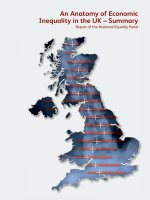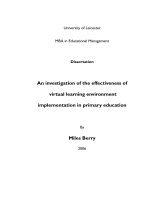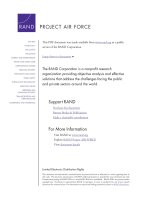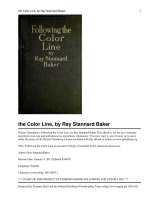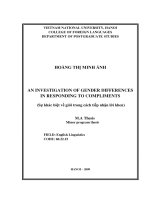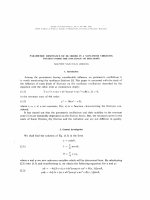An investigation of interfacial behaviour in steel concrete composite system by cohesive zone method
Bạn đang xem bản rút gọn của tài liệu. Xem và tải ngay bản đầy đủ của tài liệu tại đây (10.98 MB, 316 trang )
AN INVESTIGATION OF INTERFACIAL BEHAVIOUR
IN STEEL-CONCRETE COMPOSITE SYSTEM
BY COHESIVE ZONE METHOD
Wang Tongyun
(B.Eng. CJU, M.Eng. NUS)
A THESIS SUBMITTED
FOR THE DEGREE OF DOCTOR OF PHILOSOPHY
DEPARTMENT OF CIVIL & ENVIRONMENTAL ENGINEERING
NATIONAL UNIVERSITY OF SINGAPORE
2013
DECLARATION
I hereby declare that the thesis is my original work and it has been written by me
in its entirety. I have duly acknowledged all the sources of information which
have been used in the thesis.
This thesis has also not been submitted for any degree in any university
previously.
_________________
Wang Tongyun
18 January 2013
i
Acknowledgements
Research outcomes, especially for engineering topics, carry genes of both group
cooperation and personal endeavour. The birth of this thesis is not possible with the
support of following people, whom I would like to extend my appreciation to.
Foremost, words could not express my gratitude toward my supervisor, Prof. J. Y.
Richard Liew. He encouraged me to pursue PhD study, a never easy but fulfilling and
rewarding path. Countless discussion, suggestion, encouragement, support and
patience from Prof. Liew have shaped this thesis. Moreover, Prof. Liew has mentored
me to think creatively, to design practically and to communicate effectively. I am still
trying to meet these standards and believe these will shape my way ahead.
Managers and technicians in structural lab of NUS have helped to coordinate, setup
and instrument many rounds of tests. They include Lim Huay Bak, Stanley Wong,
Ang Beng Ong, Koh Yian Kheng and Annie Tan. Along my PhD study in NUS,
friendship was rendered by fellow researchers in Prof. Liew's steel and composite
group. K.W. Kang, M.X. Xiong, X. Yu, K.M.A. Sohel, S.C. Lee, D.X. Xiong, X.Y.
Gao, J.B. Yan and many more have made my life full of support and laughter.
Discussions on wide engineering topics may arise from office, library, laboratory,
way to lecture halls and canteens. I have benefited from discussions within this group
of friends significantly. I would also like to thank the discussion with Prof. Y.S. Choo,
Prof. Andrew Palmer and Prof. Peter Marshall on bond enhancement between steel
and concrete. Two final year undergraduate students, M.A.M. Abubucker and K.W.T.
Ma have worked with me on experimental investigation. Their assistances in
specimen preparation and testing are greatly appreciated.
ii
Lastly but dearest to my heart, this thesis is impossible without love and support from
my parents, my wife, and my sons. Their love and encouragement have always
brought hope and strength whenever there is a barrier to be overcome. I would like to
dedicate this thesis to my family.
iii
Table of Contents
Acknowledgements i
Table of Contents iii
Summary ix
List of Tables xii
List of Figures xiii
NOMENCLATURE xxii
Chapter 1 Introduction 1
1.1 Background 1
1.1.1 Conventional steel-concrete composite slab and beam 1
1.1.2 Sandwich structures 4
1.2 Significance of steel concrete interface behaviour 8
1.3 Objectives and research scopes 11
1.4 Layout of thesis 12
Chapter 2 Literature Review 15
2.1 Existing design methods for steel concrete composite structures 15
2.2 Full composite method 16
2.2.1 Material Properties 18
2.2.2 Partial factor design 20
2.2.3 Effective modular ratio 21
2.2.4 Member Buckling Effects 24
2.2.5 Determine concrete stress profile 27
2.2.6 Combined flexural and axial loads 32
2.2.7 Design of shear connectors 34
2.2.8 Plate buckling Factor 39
2.2.9 Check of design stresses 41
2.3 Partial composite and its implications 45
iv
2.4 Existing analytical and numerical modeling of deformable mechanical shear
connection 47
2.4.1 Direct 3D solid model for shear connectors 48
2.4.2 Explicit spring elements to model shear connector or interaction 53
2.5 Analytical model for bonded joint 56
2.6 Bonded steel-concrete composite beam 58
2.6.1 Modeling of bonded joint with epoxy bulk material 59
2.6.2 Modeling of bonded joint with cohesive element 60
2.7 Slip capacity of composite section 60
2.8 Closing remarks on existing models 61
Chapter 3 Cohesive Zone Method for Steel Concrete Composites 65
3.1 Introduction to CZM 66
3.2 Damage and failure mechanism of CZM 71
3.2.1 Triangular traction separation 72
3.2.2 Tri-linear and trapezoidal traction separation 74
3.2.3 Exponential traction separation 76
3.2.4 Polynomial traction separation laws 80
3.3 Determination of cohesive element stiffness 83
3.4 Mode interaction for combined tensile and shear traction 86
3.4.1 Effective opening for mode interaction 87
3.4.2 Direct modeling of model interaction 90
3.4.3 Damage initiation and evolution based on displacement or energy 96
3.5 Modeling of compressive normal traction 100
3.6 Effective damage model with tri-linear law 103
3.6.1 Effective damage parameter 103
3.6.2 Damage model for tri-linear traction separation law 106
3.6.3 Effects of mode interaction parameter β 114
v
3.6.4 Effects of different traction separation shapes interaction 115
3.7 Concluding Remarks 122
Chapter 4 Finite Element Formulation of CZM Based On Effective Damage Model125
4.1 Numerical algorithm flow chart 126
4.2 General finite element formulation of CZM 128
4.3 Formulation of tangent stiffness matrix for CZM based on effective damage130
4.4 Local numerical instability related to damage rule 132
4.5 Choice of tri-linear shape 135
4.6 Validation of the proposed effective damage model 137
4.6.1 Validation with double cantilever beam test 137
4.6.2 Validation with mixed mode bending test 143
4.7 Concluding Remarks 152
Chapter 5 Experimental Investigation of Epoxy Aided Bond Strength between Steel
and Concrete 153
5.1 Introduction of epoxy aided bond 153
5.2 Experimental investigation of bond between steel and fresh concrete 155
5.2.1 Test setup of push-out tests 156
5.2.2 Test specimens of bond between steel and fresh concrete 157
5.2.3 Test results and discussion 160
5.3 Experimental investigation of fiber reinforcement effects 169
5.3.1 Comparison of fiber steel fiber and PVA fiber 169
5.3.2 Comparison of fiber volume fraction and curing timing 173
5.4 Summary of failure modes at bonded steel-concrete interface 175
5.5 Characterization of steel-concrete interface with CZM 178
5.5.1 Numerical model of push-out test and mesh density study 179
5.5.2 Characterization of steel-fresh concrete interface with fiber reinforced
epoxy 181
5.6 Concluding remarks 183
vi
Chapter 6 Numerical modeling of steel concrete interface behavior in composite
structures 185
6.1 Application of CZM to epoxy bonded steel and concrete interface 186
6.1.1 Testing scheme and results 186
6.1.2 Simplification of 3D problem into 2D planar problem 189
6.1.3 Material model 190
6.1.4 Numerical modelling of bonded composite beam 195
6.1.5 Numerical results and discussion 197
6.1.6 Numerical simulation of bonded composite beam subjected to uniformly
distributed load 200
6.1.7 Effect of bond strength for bonded composite beam 202
6.2 Numerical study of bonded SCS sandwich beam 209
6.2.1 Effects of bond strength 209
6.2.2 Numerical model for SCS6-100-6 214
6.2.3 Effects of fiber reinforcement at interface 218
6.2.4 Effects of interfacial friction coefficient 219
6.3 Application of CZM to model shear connectors 222
6.3.1 Choice of proper traction separation law 223
6.3.2 Characterization of mechanical shear connector by CZM 225
6.3.3 Numerical simulation of load sharing mechanism 229
6.4 Numerical model of mechanically connected composite beam 233
6.5 Numerical modeling of mechanically connected SCS sandwich beam 239
6.5.1 Numerical model of three point loaded SCS sandwich beam 240
6.5.2 Numerical results and discussion for full composite sandwich beam 241
6.5.3 Numerical results and discussion for partial composite sandwich beams 245
6.6 Proposal of framework to determine and implement traction separation law250
6.7 Concluding Remarks 254
vii
Chapter 7 Conclusions and Future works 257
7.1 Conclusions and contributions 257
7.1.1 Development of tri-linear traction separation law 257
7.1.2 Development of effective damage model 258
7.1.3 Modeling of different unloading and reloading behaviors 258
7.1.4 Modeling and treatment of compressive behavior of CZM 258
7.1.5 Finite element implementation of effective damage based CZM 259
7.1.6 Experimental investigation of bond performance between steel and fresh
concrete aided by epoxy 260
7.1.7 Effect of fiber reinforcement in epoxy bond line 261
7.1.8 Proposed numerical model for steel-concrete composite structure 262
7.1.9 Numerical modeling and parametric study of bonded composite and
sandwich beam 263
7.1.10 Numerical study of mechanical connected composite and sandwich beams264
7.1.11 Proposal of standard framework to test, characterize and model steel-
concrete interfacial behavior 265
7.2 Recommendation for future works 266
7.2.1 Experimental investigation on mode mix of composite connection 266
7.2.2 Quadratic UEL employing the proposed effective damage model with tri-
linear law 266
7.2.3 Numerical model for 3D problems and development of VUEL for explicit
solver 267
7.2.4 Implementation of tri-linear CZM to investigate composite structure's
fatigue performance 269
7.2.5 Development of hybrid composite connection 270
References 271
APPENDIX A. Source code of tri-linear traction separation law user element for
ABAQUS 279
viii
ix
Summary
Both conventional composite construction and novel steel-concrete-steel sandwich
construction aim to optimally utilize steel and concrete materials. The key to the
development of a novel steel-concrete composite system is to ensure an effective load
transferring mechanism at steel-concrete interface. This is achieved by either discrete
interfacial connection such as mechanical connectors; or continual interfacial
connection, e.g. structural adhesive; or a combination of preceding two. Diverse
interfacial failure mechanisms request an accurate, efficient and versatile numerical
model to predict the mechanical responses of composite structures.
This research work proposes cohesive zone model (CZM), which rooted in the field of
fracture mechanics, as a novel approach to study composite structures numerically.
Both shear and tensile behaviors are incorporated in CZM. In order to model versatile
interfacial failure mechanism, a tri-linear traction separation law is derived capable of
approximating triangular, exponential and trapezoidal laws. Most importantly, it can
model the hardening effect found in typical tensile and shear resistance of mechanical
connectors. To account for the mode interaction between shear and tension, an
effective damage model is proposed. It can incorporate different pure mode shapes in
the same element, which is difficult for many other CZMs. In addition to the
conventional unloading reloading path for adhesive joint, a model is developed for
different unloading-reloading path of mechanical connectors.
Finite element formulation is derived for the proposed CZM. A user defined element
is developed accordingly for easy application as ABAQUS subroutine. Techniques to
alleviate numerical local instability associated with damage have been proposed. The
accuracy and efficiency of the new model are verified by analytical, testing and others’
x
numerical results. A parametric study shows that initial stiffness and shape of traction
separation law does not have significant effect on pure mode damage. However,
mixed mode problems are sensitive to these factors.
Experimental investigation on epoxy aided steel to fresh concrete bond performance
have identified deterministic factors affecting bond performance including surface
roughness, superplasticizer, and curing time. The failure mode is found to be brittle in
nature. This study hence further explores fiber reinforcement effect for epoxy bond
line. Shortcut PVA fiber is found to be effective to improve the bond performance
between steel and fresh concrete. Typical test results are characterized by exponential
law.
Numerical model based on the proposed CZM is proposed to contain damage at
interfacial layer. Fictitious cohesive zone is employed to eliminate definition of
contact. Advanced finite element analyses have been carried out using CZM to study
various steel-concrete composite systems. The proposed numerical model achieves
good agreement with testing results including: push-out test involving a hybrid
Expamet-hook connector system; epoxy bonded composite beam subjected to 4-point
bending; mechanically connected composite beam subjected to hogging moment; and
mechanically connected sandwich beams subjected to 3-point bending. Bonded
sandwich beam subject to pure bending is also studied numerically to identify the
requirements for bond strength. Effects of fiber reinforcement at epoxy bond layer are
also demonstrated.
Numerical parametric study using the proposed new method has made it possible to
study the structural behavior of composite beams from a holistic perspective. It is
revealed that interfacial shear strength and tensile strength have different significant
xi
levels to ensure effective composite action. For continuously bonded steel-concrete
composite beam, shear bond strength is of uttermost importance. For intermittently
bonded composite beam, tensile bond strength is the critical factor to prevent
premature failure of bonded steel-concrete composite beam; whereas higher shear
bond strength does not necessarily ensure effective composite action. For mechanical
shear connectors, not only shear strength but also slip capacity determine the global
load carrying capacity of a partial composite beam. Parametric study shows the
importance of realistic load slip curves. Therefore, a standard framework to test,
characterize and model steel-concrete interfacial behavior is proposed.
xii
List of Tables
Table 2.1 Modeling of steel material behavior (EN 1993-1-5:2006) 19
Table 2.2 Load partial factors for SCS sandwich system design 20
Table 2.3 Material partial factors for SCS sandwich system design 20
Table 2.4 Stress diagrams and effective sections 28
Table 4.1 DCB verification CZM properties 138
Table 4.2 Parameters to define CZM in MMB test 145
Table 5.1 Summary of bond strength of steel to fresh concrete 159
Table 5.2 Failure loads of various type of concrete 161
Table 5.3 Failure loads with different surface roughness of steel plate 162
Table 5.4 Failure loads with different SP volume 166
Table 5.5 Failure loads with different pressure during curing 168
Table 5.6 Characterization parameters for PVA reinforced epoxy bond performance
183
Table 6.1 Parametric study on bonded composite beam 204
Table 6.2 Comparison of numerical results of bonded SCS beam subject to 3-point
bending with various friction coefficients 221
Table 6.3 Tri-linear CZM parameters for push-out test of combined Expamet and J-
hook connectors 231
Table 6.4 Parameter sets for modeling SCS100 with tri-linear traction separation
CZM 243
xiii
List of Figures
Figure 1.1 Typical composite beam/slab (BSI 2004) 2
Figure 1.2 Different composite beam/slab constructions (Tata Steel Web Page) 2
Figure 1.3 Example of bonding steel plate to bridge’s RC beam soffit by U.K. Traffic
Research Lab 3
Figure 1.4 Honeycomb sandwich panel 5
Figure 1.5 Double skin sandwich construction utilizing overlapped shear studs 6
Figure 1.6 SCS sandwich construction utilizing bi-steel 6
Figure 1.7 Polyurethane SPS developed by Intelligent Engineering and BASF
(Kennedy 2004) 7
Figure 1.8 SCS sandwich system developed in NUS (Liew et al. 2009) 7
Figure 1.9 Steel-Concrete interfacial connection forms 9
Figure 2.1 Typical failure modes of SCS sandwich system: (a) tensile plate yielding (b)
compressive plate buckling (c) shear connector failure (SCI 1997) 17
Figure 2.2 Stress strain curve of concrete (a) nonlinear model; (b) simplified bi-linear
model 19
Figure 2.3 Effective cross section 21
Figure 2.4 Flowchart to calculate effective modular ratio of SCS sandwich section 23
Figure 2.5 Examples of different buckling modes and corresponding effective lengths
25
Figure 2.6 Transformed section to calculate 25
Figure 2.7 Flowchart to determine member buckling effect 26
Figure 2.8 Transformed section to determine section profile: (a) Un-cracked concrete
core (b) Fully cracked concrete core 27
Figure 2.9 Flowchart to determine concrete stress profile and member stresses 31
Figure 2.10 Strain diagrams under combined flexural and axial loadings 32
Figure 2.11 Flowchart to determine total stresses due to combined loads 34
Figure 2.12 Flowchart to design for shear connectors 38
Figure 2.13 Face plate among shear connectors 39
I
δ
xiv
Figure 2.14 Flowchart to calculate face plate buckling factor 41
Figure 2.15 Flowchart to check stresses 42
Figure 2.16 Preliminary sizing design chart for f
y
=235MPa, h
c
=100mm various
concrete strengths and plate thicknesses 43
Figure 2.17 Preliminary sizing design chart for f
y
=275MPa, h
c
=100mm various
concrete strengths and plate thicknesses 44
Figure 2.18 Preliminary sizing design chart for f
y
=355MPa, h
c
=100mm various
concrete strengths and plate thicknesses 45
Figure 2.19 Kalfas' mixed 3D FE model of steel-concrete push out test 49
Figure 2.20 Clubley et al.'s 3D FE model mesh 50
Figure 2.21 El-lobody's FE model for shear connector 50
Figure 2.22 Ellobody's FE model for composite beam with profiled steel sheeting 51
Figure 2.23 Xie et al.'s FE model for friction welded shear connector 52
Figure 2.24 Gattesco's spring and interfacial slip model 53
Figure 2.25 Clubley et al.'s smeared connection with 2-way spring 54
Figure 2.26 Lee et al.'s FE model using beam element 55
Figure 2.27 Simplified 2D FE model for Steel-Concrete-Steel sandwich beam
(Foundoukos et al. 2008) 56
Figure 2.28 Analytical and numerical model of fracture energy release rate by (Au et
al. 2006) 59
Figure 2.29 Shear spring used to model the interface between concrete and adhesive
60
Figure 3.1 Typical composite failure modes and corresponding traction separation
curves 65
Figure 3.2 Crack process zone concept 69
Figure 3.3 Comparison of typical traction-separation constitutive laws 72
Figure 3.4 Comparison of corresponding typical damage evolutions 72
Figure 3.5 Typical bi-linear traction separation law 74
Figure 3.6 Variance of tri-linear traction separation law 76
Figure 3.7 Exponential traction separation law for normal and shear modes 79
xv
Figure 3.8 Effect of elastic cohesive stiffness 84
Figure 3.9 Effect of interface stiffness 85
Figure 3.10 Mode mix of effective opening model in terms of normal traction T
n
89
Figure 3.11 Mode mix of effective opening model in terms of tangential traction T
t
. 89
Figure 3.12 Mode mix of exponential law in terms of potential energy 91
Figure 3.13 Mode mix of exponential law in terms of normal traction T
n
92
Figure 3.14 Mode mix of exponential law in terms of tangential traction T
t
92
Figure 3.15 Mode mix of PPR model in terms of potential energy 95
Figure 3.16 Mode mix of PPR model in terms of normal traction T
n
95
Figure 3.17 Mode mix of PPR model in terms of tangential traction T
t
96
Figure 3.18 EPZ model using trapezoidal law 98
Figure 3.19 Normal traction separation damage using PPR model 99
Figure 3.20 Comparison of models with same parameters other than initial stiffness
100
Figure 3.21 Mode mix of PPR model in terms of normal traction T
n
considering
interfacial compression 102
Figure 3.22 Mode mix of PPR model in terms of potential energy considering
interfacial compression 103
Figure 3.23 Modes interaction defined by 105
Figure 3.24 Different typical unloading and reloading behaviors for adhesive bond
(Alfano et al. 2009) and mechanical shear connectors (Topkaya et al. 2004) 107
Figure 3.25 Two laws for damage unloading and reloading paths: (a) adhesive bond;
(b) mechanical connector 108
Figure 3.26 Traction of tri-linear cohesive law with permanent "separation" 110
Figure 3.27 Comparison of energy of tri-linear cohesive laws with different damaging
behaviors 111
Figure 3.28 Mode mix of effective damage model in terms of effective damage D
eff
113
Figure 3.29 Mode mix of effective damage model in terms of normal damage T
n
113
Figure 3.30 Mode mix of effective damage model in terms of tangential damage T
t
114
Φ
Φ
Φ
β
xvi
Figure 3.31 Effect of mode interaction parameter β on effective damage vs.
separations 115
Figure 3.32 Effective damage parameter with different pure mode behaviors 117
Figure 3.33 Normal traction with different pure mode behaviors 119
Figure 3.34 Tangential traction with different pure mode behaviors 119
Figure 3.35 Comparison of effect of β on normal traction with different pure mode
behaviors 120
Figure 3.36 Comparison of effect of β on tangential traction with different pure mode
behaviors 121
Figure 4.1 Effects of number of damage tabular points in ABAQUS 126
Figure 4.2 Flowchart for the developed UEL 127
Figure 4.3 Node and coordinate system of 2D 4-node cohesive element 128
Figure 4.4 Illustration of local instability due to sudden drop of stiffness 134
Figure 4.5 Comparison of artificial damping and MDT element deletion 135
Figure 4.9 Options for choice of equivalent tri-linear model 136
Figure 4.10 Model of DCB test 138
Figure 4.11 Comparison of numerical results and analytical solution 140
Figure 4.12 Various initial stiffness and shapes for parametric study with same
cohesive strength and fracture toughness 141
Figure 4.13 Effects on the initial stiffness of DCB test simulation 141
Figure 4.14 effect on the maximum strength and post-peak behavior of DCB test
simulation 142
Figure 4.15 Model for MMB test (Park et al. 2009) 144
Figure 4.16 FE mesh of MMB testing specimen (crack propagated) 146
Figure 4.17 Comparison of numerical results with and without element deletion based
on MDT 147
Figure 4.18 Comparison of numerical results with analytical results 148
Figure 4.19 Effect of mode interaction parameter β on tangential traction 149
Figure 4.20 Close comparison when crack starts to propagate 150
Figure 4.21 Close comparison when crack extents over central span loading point . 150
xvii
Figure 4.22 Demonstration of shape effects for mode mix 151
Figure 5.1 Typical resin material 154
Figure 5.2 Typical epoxy polymerization to form cross-link 154
Figure 5.3 Schematic topography of solid surfaces (Arnold 1981) 155
Figure 5.4 Push-out test specimens of bonded steel-concrete composite 156
Figure 5.5 Push out test arrangement 157
Figure 5.6 Set-up of pressurized curing of specimens 159
Figure 5.7 Load slip curve for different types of concrete and different water to
concrete volume ratio 161
Figure 5.8 Load slip curve for different steel surface roughness 162
Figure 5.9 SEM comparison of ground (top) and grit-blasted (bottom) surfaces
(Franklin et al. 2003) 163
Figure 5.10 Comparison of failure interfaces of specimens using smooth steel plates
and sandblasted steel plates 164
Figure 5.11. Different failure modes of push out specimens using (a) sandblasted steel
plate and (b) smooth steel plate 164
Figure 5.12 Load-slip curves for different super plasticizer volume 165
Figure 5.13 Homopolymerization due to existence of catalyst of caboxyl base or
tertiary amine (superplastisizer) 167
Figure 5.14 Load slip curve for specimens with different initial pressure during curing
168
Figure 5.15 Steel fiber (left) and PVA fiber (right) used in current study 171
Figure 5.16 Comparison of steel fiber and PVA fiber failure interface 171
Figure 5.17 Failure surface at steel plate side showing mix mode and fiber bridging
171
Figure 5.18 Failure surface at concrete side showing mix mode and fiber bridging . 172
Figure 5.19 Fiber bridging effect during crack propagation 172
Figure 5.20 Typical load-slip curve of 3% PVA reinforced epoxy bond interface 173
Figure 5.21 Typical load-slip curve of 5% PVA reinforced epoxy bond interface 174
Figure 5.22 Typical load-slip curve of 7% PVA reinforced epoxy bond interface 174
xviii
Figure 5.23 Comparison of steel-concrete interfacial strength with fiber percentage
and curing time 175
Figure 5.24 Failure modes observed at the bonded steel-concrete interface 176
Figure 5.25 Comparison of load-displacement curve of perfect bond interface using
implicit and explicit solver 177
Figure 5.26 Shear stress along steel-concrete interface 178
Figure 5.27 Various mesh density of push-out test model 180
Figure 5.28 Comparison of numerical results for push-out testing with different mesh
densities 180
Figure 5.29 Comparison of test results and exponential CZM characterized curves 182
Figure 6.1 Specimen configurations and test setup of 4-point bending test (Souici et al.
2013) 187
Figure 6.2 Assumed distribution of epoxy bond patch for specimen B5 187
Figure 6.3 Four point bending testing results of bonded and mechanically connected
composite beams (Souici et al. 2013) 188
Figure 6.4 Verification of 2D section with analytical solution 190
Figure 6.5 Yield surface of concrete damage plasticity model (ABAQUS 2010) 191
Figure 6.6 Concrete compressive stress strain curve 193
Figure 6.7 Concrete fracture energy cracking criterion under tension (ABAQUS 2010)
194
Figure 6.8 Numerical model of bonded composite beam: boundary conditions and
section assignment 196
Figure 6.9 Load displacement curves for bonded composite beam comparing
numerical and experimental results 198
Figure 6.10 von Mise Stress distribution of bonded steel-concrete composite beam 199
Figure 6.11 Plastic strain distribution of bonded steel-concrete composite beam 199
Figure 6.12 Simulated slip between steel section and concrete slab 200
Figure 6.13 Comparison of load vs. interfacial slip curves 200
Figure 6.14 Comparison of full and partial composite beams subjected to UDL and
FPB 202
Figure 6.15 Effects of shear bond strength on continuously bonded composite beam
207
xix
Figure 6.16 Effects of tensile bond strength on continuously bonded composite beam
207
Figure 6.17 Effects of shear bond strength on intermittently bonded composite beam
208
Figure 6.18 Effects of tensile bond strength on intermittently bonded composite beam
208
Figure 6.19 FE Model of bonded SCS sandwich beam subjected to pure bending 209
Figure 6.20 Moment vs. rotation curve of SCS 2-100-2 with various bond strengths
210
Figure 6.21 Buckling and crack distribution in bonded SCS 2-100-2 beam 212
Figure 6.22 Shear cracks between bottom face plate and concrete core for SCS 2-100-
2 beam 213
Figure 6.23 Moment vs. rotation curve of SCS 6-100-6 with various bond strengths
215
Figure 6.24 Buckling and crack distribution in bonded SCS 6-100-6 beam 216
Figure 6.25 Shear cracks between bottom face plate and concrete core (6-100-6) 217
Figure 6.26 Effect of fiber toughening on SCS 6-100-6 sandwich beam 218
Figure 6.27 Failure modes comparison without and with fiber toughening 219
Figure 6.28 Effects of Steel-Concrete Friction Coefficients on the Behavior with SCS
Beam Subject to 3 Point Bending 221
Figure 6.29 Comparison of friction coefficient effects 222
Figure 6.30 Shear vs. slip model by (Ollgaard et al. 1971) using various parameters by
other researchers 224
Figure 6.31 Typical shear vs. slip curve by tests (Bro et al. 2004) 224
Figure 6.32 Demonstration of limitation of Ollgaard's model (Loh et al. 2004) 224
Figure 6.33 Characterization of load-slip curve by (Bärtschi 2005) 225
Figure 6.34 Typical different push-out test results 226
Figure 6.35 Typical push-out test results with various shear connector diameters 227
Figure 6.36 Typical push-out test results with various concrete thickness 228
Figure 6.37 Typical tensile load-slip curves for J-hook shear connector 228
Figure 6.38 Product Expamet used to enhance bond strength 230
xx
Figure 6.39 Interfacial load sharing by shear connector and Expamet 230
Figure 6.40 Characterization of shear connector by tri-linear model 232
Figure 6.41 Characterization of Expamet by tri-linear model 232
Figure 6.42 Comparison of load slip curves by experiments and numerical simulation
233
Figure 6.43 Specimen dimensions and test setup for beam type C 234
Figure 6.44 Comparison of shear studs behavior with different traction separation
laws 235
Figure 6.45 Comparison load deflection curves of beam type C 236
Figure 6.46 Comparison of load slip curves of composite beam type C 237
Figure 6.47 Distribution of interfacial slip along composite beam type C 237
Figure 6.48 Tri-linear models for shear connectors with various slip capacities 238
Figure 6.49 Numerical results of Beam Type C with various connector slip capacities
239
Figure 6.50 SCS sandwich beam plastic strain distribution for: (a) without shear
connector (b) with elastic connector 241
Figure 6.51 Sections of SCS sandwich beam with mechanical shear connectors 241
Figure 6.52 Comparison of load deflection curves for SCS100 242
Figure 6.53 Various tri-linear traction separation laws for hook connector of SCS100
244
Figure 6.54 Tri-linear model of tensile tests for hook connector of SCS100 244
Figure 6.55 Comparison of load-deflection curves for SCS100 parametric study 245
Figure 6.56 Tri-linear model of shear tests for hook connector of SLCS200 and
SLFCS300 247
Figure 6.57 Comparison of load deflection curves for SLCS200 247
Figure 6.58 Comparison of load deflection curves for SLFCS300 248
Figure 6.59 Comparison of SLFCS300 deformation 248
Figure 6.60 Failure of connectors by shear at bottom plate 248
Figure 6.61 Distribution of interfacial slip along the bottom surface of SLFCS300 at
different stages (left is beam end, right is central load line) 249
xxi
Figure 6.62 Illustration of (a) pull-out and (b) pull-out tests 250
Figure 6.63 Proposed framework to test and characterize steel-concrete interfacial
behavior 252
Figure 6.64 Framework to implement tri-linear effective damage model using UEL
253


